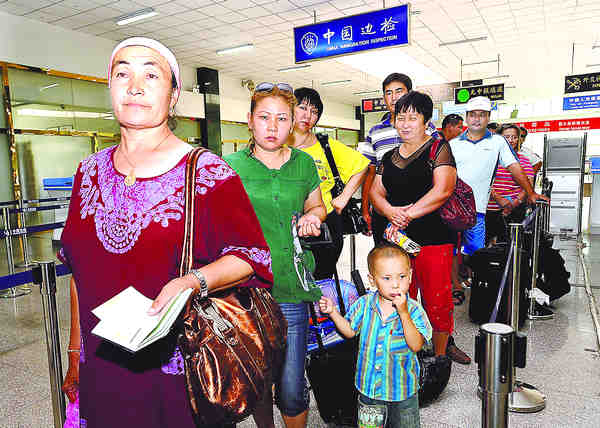Foreign and Military Affairs
Horgos Port returns as major gateway
Updated: 2011-06-14 07:43
By Wang Xing (China Daily)
|
 People heading for Kazakhstan wait in line for customs clearance procedures at Horgos Port in the Xinjiang Uygur autonomous region in this file photo taken on July 20, 2009. [Photo / Xinhua] |
Horgos, Xinjiang - Cross-border travel at Horgos Port connecting China and Kazakhstan is expected to see a 45-percent jump in the second quarter of this year, as booming trade between the two countries boosts business demand.
Ning Xin, chief of the Entry-Exit Administration Office at Horgos Port, told China Daily that personal crossings at the port will exceed 160,000 in the second quarter of this year, up from 110,000 in the same period of last year.
|
||||
Horgos Port is a major land port in the Ili Kazak autonomous prefecture, Northwest China's Xinjiang Uygur autonomous region. Its history can be traced back to China's Sui Dynasty (AD 581-618), when the port served as part of the Silk Road trade routes.
After 1949, the port was renovated and served as the biggest trade port in western China with the Soviet Union.
But the later souring relationship between the two communist countries led to the port's decline.
In 1983, the Chinese government decided to restore the port and invested heavily in infrastructure construction, and it soon became the major connection between western China and middle Asian countries.
"Horgos Port has changed so rapidly in the past three years I can hardly recognize it," said Chen Guodong, a 65-year-old who lives in Yining, capital city of Ili Kazak autonomous prefecture.
He said his son and daughter both trade with Kazakhstan, which brings the family more than 6,000 yuan ($925) every month.
With the breakdown of the Soviet Union in the 1990s, Kazakhstan and other former Russian satellite countries, though abundant in natural resources such as oil and minerals, found themselves in great need of everyday articles and agricultural goods. That spurred a great demand to trade with neighboring China, which is equally thirsty for natural resources to fuel its rapid growth.
According to official figures, China's trade with Russia, Kazakhstan, Kyrgyzstan, Tajikistan and Uzbekistan reached $86.8 billion in 2008, a more than 7-fold increase over 2001.
Ning said about half of the travelers at Horgos Port are from Kazakhstan, and the rest are from other Central Asian countries.
He added that after the first free border trade zone in China is established in Horgos, he and his colleagues will be even busier.
E-paper

Pearl on the Yangtze
Wuxi is considered a town of natural beauty and its motto is "city of water and warmth".
Prose and consternation
Riding on a mystery train
Way of a warrior
Specials

Wealth of difference
Rich coastal areas offer contrasting ways of dealing with country's development

Seal of approval
The dying tradition of seal engraving has now become a UNIVERSITY major

Making perfect horse sense
Riding horses to work may be the clean, green answer to frustrated car owners in traffic-trapped cities



